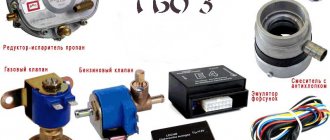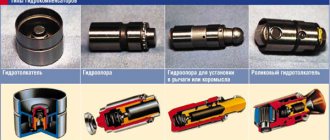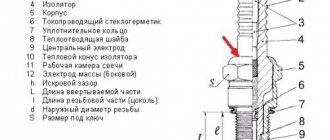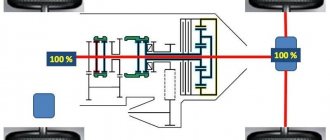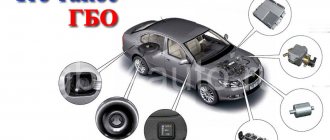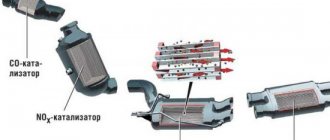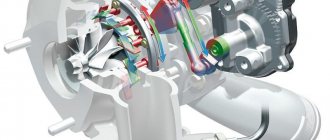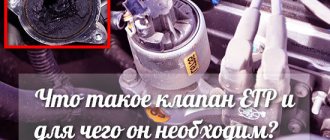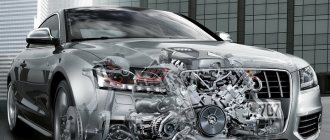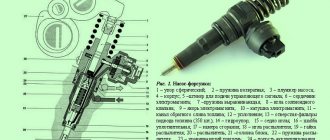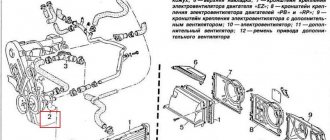In this article you will learn the nuances of how to install 2nd generation HBO on an injector. In particular, what difficulties are expected during installation. As you know, the second generation of gas equipment is designed to work with carburetor engines.
It does not monitor engine parameters using multiple sensors. When installed on an injection engine, it will be necessary to adapt the gas system to the internal combustion engine control system. In other words, you need to use those elements that are present in the 4th generation HBO. Now it's time to find out what you need for such an upgrade.
Basic information about car gas equipment
As you know, gas equipment is installed on a car in which the main power system is gasoline or diesel. In other words, after installation you get a dual-fuel engine. For injection engines, it is important to use fourth and third generation systems. The fifth generation is also ideal, but it is very expensive. Its cost is about two thousand dollars.
And the price of the gas pump, which is the main element of the system, is approximately half the cost of the entire gas equipment set. The second generation LPG is the cheapest; it can, if desired, be adapted for operation on an injection engine. True, you will need to install an additional control unit and adapt it to the standard ECU.
List of equipment for installing gas equipment with your own hands
1
.
HBO kit. The choice of kit directly depends on the make of the car. The main set consists of wires, a computer, harnesses, hoses, valves, injectors, gas temperature sensors, pressure sensors and a reducer. In some cases, the equipment may differ. 2
. Gas cylinder. When installing gas equipment, most motorists try to achieve compactness. To do this, you should use cylinders in the form of a torus. One of the most popular on the modern market is the Atiker cylinder, measuring 630 by 255 mm, holding 54 liters of blue fuel.
3
. Multivalve. The package of modern multivalves includes the device itself, a remote system for refilling cylinders and tubes.
4
. Gas level sensor. A device that connects to the computer of a gas cylinder installation. The main task of the sensor is to display the remaining fuel in the cylinders.
5
. Universal programmer. Used to debug and configure the computer.
6
. Computer and disk with setup instructions. On the disk you will find firmware, instructions and diagrams.
7
. Injectors, harnesses.
8
. Set of tools.
This is a minimum list of equipment that will be enough to install gas equipment with your own hands. Depending on the vehicle, the cost of equipment may vary. In most cases, the amount depends on the brand, type, manufacturer, configuration and model of the cylinder. Installation of 4th generation gas equipment will cost approximately 20 thousand rubles.
In some cases, the standard equipment of HBO is not enough and the motorist has to purchase:
✓ 2 copper hoses (6 and 8 mm in diameter, 1.5 and 8 m long;
✓ pressure sensor;
✓ connector for connecting the sensor to the HBO computer.
Main components of gas equipment
Now let’s look at what the standard set that is installed on cars consists of. Gas-cylinder equipment cannot operate without a special fitting, with the help of which fuel is refueled. As a rule, it is installed in the rear of the car or near the gas tank filler neck. A special cylinder is installed in the luggage compartment, which has a cylindrical or toroidal shape, depending on which 2nd generation LPG kit you purchase.
The latter fits perfectly into the spare wheel compartment. Also, for the normal functioning of the gas cylinder equipment system, it is necessary to install a key in which an indicator of the balance in the gas cylinder is mounted. It also has a built-in fuel switch (gas-petrol). To inject gas into the intake manifold, special electromagnetic injectors are needed. They are supplied with a gas-air mixture under a certain pressure. It enters the intake manifold through special hoses. But before this, it is necessary to clean the gas mixture, for which you need to use a special filter.
To regulate the gas pressure supplied to the injectors, an evaporator reducer should be used. This is a device that allows you to reduce the pressure in the gas cylinder to the value necessary for the operation of the electromagnetic injectors.
Installation diagram
- Gas container (cylinder)
- Multivalve
- High pressure fuel line
- Refueling remote accessory
- Gas valve
- Reducer-evaporator
- Fuel mixture dispenser
- Gasoline valve
- Fuel switch
According to the fuel supply scheme, GB equipment is conventionally divided into generations. For example, let's look at early systems and analyze their working algorithm. A propane-butane mixture in a liquefied state, contained under a certain pressure in a specialized container, is supplied to the high-pressure pipeline through a special multi-valve that records fuel consumption. With the help of this valve and a remote refueling device, refueling is carried out. Next, the liquefied gas passes through the pipeline through a gas valve, additionally equipped with a filter element, where it is purified from various impurities and resinous compounds. This system mechanism, when the ignition is turned off and the engine operating mode is switched to gasoline, shuts off the supply of the gas mixture.
Next, the clean gas moves through the pipeline to the reducer, where its pressure is reduced to atmospheric pressure. As a result of this procedure, the gas mixture begins to evaporate intensively. A vacuum forms in the manifold of a running engine, which allows the gas mixture to pass through the low-pressure hose. Then the gas is directed through the dispenser to the fuel mixer, which is located between the throttle and air filter. On carburetor engines, a gas fitting can be used.
The required type of fuel for engine operation is switched on by a fuel switch from the car interior, which is located on the panel. When the “gas” mode is turned on, the switch activates the opening of the gas valve, and at the same time the gasoline valve closes. When the operating mode of a car engine is switched to gasoline, the gas valve closes accordingly. Thanks to the backlight provided for the switch, you can always see what fuel the engine is running on.
Operating principle of gas equipment
To control an engine that runs on a gas mixture, you need to use a special device. It is based on a microcontroller, which receives signals from all sensors used in the internal combustion engine. You can also use (in the case of upgrading the second generation ECU) electronic engine control systems that can work with two firmwares. If you have a microcontroller of the “January” 5.1 family installed on your car, you can easily install a 2nd generation LPG kit on an injection engine.
All the necessary sensors are already on the engine; you just need to change the firmware of the electronic control system. To improve the efficiency of your entire system, as well as to comply with environmental regulations, it is necessary to adapt the control unit to the lambda probe. When gas passes through the fuel line, it is cleaned by a filter element and then enters the gearbox. It is connected to the cooling system of the internal combustion engine and serves as an evaporator for gas fuel.
In addition, it helps regulate the fuel pressure. After the gas reduces its pressure, it enters the nozzles. It is worth noting that the 2nd generation LPG on the carburetor has almost identical elements to those installed on the injector. True, there is one difference. Second generation gas cylinder systems do not have such advanced electronic filling.
Computer tuning of gearboxes using TGStream PM 4th generation
Significantly more modern mechanisms, fully controlled and adjusted remotely. They do not require monotonous rotation of screws back and forth and have significantly higher accuracy. But the cost of the kit, which includes a new generation Tomasetto gearbox and the Tamon TGStream PM control unit, is significantly higher, and the device is not suitable for all cars, but only for injection cars with a fuel supply method with:
- distributed injection by phases;
- separated pair injection into the manifold;
- distributed simultaneous entry of the mixture into the collector;
- mono-injection of gasoline.
Tamon's TGStream PM electronic system will also allow the use of Tomasetto units with direct fuel injection into the engine, acting as generation 4+ equipment (with the ability to force start only on gas without gasoline).
All setup operations are carried out through a connection via a USB port located on the front cover of the Tamon TGStream PM unit case to a laptop. The adjustment is carried out by a special program that can be downloaded and installed by downloading the software for the corresponding Tomasetto model from the manufacturer’s website. You can only adjust the hose for uniform gas supply with your own hands.
Processes occurring in the system
Let us next consider what processes occur in the HBO system. The antifreeze that is in the gearbox gives off heat. Due to this, the gas is heated. It begins to change from liquid to gaseous form. Please note that you are filling a gas cylinder with liquid fuel, as it is under enormous pressure. Between the gearbox and the fuel rail in which the injectors are mounted, there is a filter element for fine cleaning. And now a little about what happens in the electronic stuffing.
The microcontroller receives all the information from the engine sensors installed on the car. In addition, it analyzes information from sensors directly in the gas equipment system. By making a complete analysis, it makes the fuel management as ideal as possible. The electronic control unit contains a special fuel map adapted for operation on gas. The 2nd generation gas system for the carburetor does not have electronic filling, for this reason its gas consumption is much higher and its reliability is less. If you add artificial intelligence to the system, it becomes more efficient.
How is the gearbox controlled?
The 2nd generation Lovato gas reducer has its own characteristics. In general, gas is sensitive to many important points and changes in the operation of the system. It happens that gas equipment was installed, but then increased fuel consumption or other problems with the engine appeared. Let's say the car starts to start slowly or stalls regularly. In this case, it is better to adjust the gearbox.
What needs to be done for this? To familiarize yourself with the process features, you can view a diagram of the existing pins and control components.
Adjust the electric gearbox. You have regulators available - fluid pressure (2) and gas volume (2). The following algorithm of actions must be followed:
- switch to gasoline, turn on the car and warm up the engine to 95 degrees;
- set the speed to 900-1100 rpm and turn off the fuel supply (in this case, gasoline);
- set the initial positions of the adjusting screws: set the dispenser to the extreme mark, turn the XX regulator (2) all the way and then turn it exactly 5 turns, turn the 1 regulator all the way.
Put XX. Namely:
- Switch the control to gas and turn on the car. Using the choke, set the speed of the power unit to around 2 thousand;
- gradually return the choke to its place and unscrew the XX regulator (2). Do this until the maximum engine speed is achieved. What does it mean? Turn screw 2 until the speed stops increasing. When you reach the specified goal, stop;
- operate in the sequence described until the suction is fully recessed;
- turn the adjusting screw (2) evenly. It is necessary to reach such a state that the sum of revolutions becomes presumably the same as when running on gasoline. During adjustment, you must remember that after rotating the regulator, the reaction to changes is not observed instantly, but after some time. This means that you definitely need to take a break.
Adjust the sensitivity of the gearbox. Everything is simple here. Turn the adjusting screw (1) until the XX speed decreases (increases) (again, do not forget about the delays). After this, turn the regulator slightly back - 1.25 rpm. Next, try to apply pressure on the gas. It is perfect if the car immediately responds to your actions.
However, it is important not to forget one more thing. If the adjusting screw “1” was not tightened well enough, it is preferable to leave it untouched. Among other things, provided that the engine capacity is less than 3 liters, then it is also better not to touch the described screw.
Set up the dispenser. To this end:
- set the number of revolutions to 3500. Accordingly, it is preferable to involve an assistant in the process and ask him to press the gas (do not use the choke). No helpers found? It is necessary to secure the throttle cable using a screwdriver;
- Turn the adjusting screw until changes in speed appear. Turn the screw to the left and to the right to make sure that all actions were carried out correctly;
- turn the screw until the speed increases. As soon as the rotation stops producing results, you need to stop;
- From now on, turn the screw 0.75 rpm. from the limit.
- Call an assistant and ask him to press the gas. Do not forget to turn screw 2 by 1/4 turn at the same time. There should be a feeling of a slight decrease in speed;
- turn the sensitivity screw half a turn;
- re-adjust the dispenser.
Measure the level of carbon dioxide in the exhaust. The standard figure is around 0.35%. Are the numbers too high? Turn the XX screw on the gearbox and increase the air injection (for this, use a special screw on the carburetor). If reduced speed is observed, the opposite actions should be taken.
If possible, to correctly configure and adjust the 2nd generation HBO, use a lambda probe emulator. It allows you to see to what extent the work has been done accurately. At the same time, you can make any necessary adjustments along the way.
A simplified method used when repairing 2nd generation gas equipment with your own hands (Lovato brand) is the basics of adjustment (sensitivity bolt in combination with a greed bolt):
- The membrane sensitivity bolt is completely screwed in until it stops slightly.
- Next, unscrew the sensitivity bolt 5 turns from the twisted position.
- The greed bolt (main chamber) on the hose is screwed in, in turn, to a slight stop.
- After this, unscrew the greed bolt 3 turns from the twisted position.
HBO and ignition system
Next, you need to control the ignition timing. As you know, liquefied gas has a very high octane number, much higher than that of any other brand of gasoline. Just imagine, the octane number of gas is in the range of 105-110. Let's say there is an engine that runs only on AI-80 gasoline. If you fill it with 98-octane gasoline without making any adjustments to the ignition timing, the engine will fail quite quickly.
The exhaust valves burn out first. Consequently, the motor power drops several times. We can say that it is precisely because of this that many are afraid to use 2nd generation HBO, the price of which on the market is only 7-10 thousand rubles. And this is the reason. The fact is that 98-grade gasoline burns much more than 80-grade gasoline. Consequently, it will burn for some time in the exhaust manifold. Exactly the same story will happen if you operate a car on gas fuel without adjusting the ignition angle.
In addition, on injection engines this will certainly lead to breakdown of the catalytic converter, since the exhaust gases will have a very high temperature. From all that has been said, we can conclude that it is necessary to compensate for the long combustion time of the gas by igniting it earlier. To do this, it is necessary to increase the lead angle. If everything is done as it should be, then the gas-air mixture will burn only in the engine cylinder, only burnt fuel will begin to flow into the catalyst and exhaust manifold. This will result in an increase in engine efficiency, a decrease in gas consumption, and an increase in useful power.
Is it possible not to install decoys (emulators)
In an attempt to save a little money, some motorists are wondering whether it is possible not to install a lambda emulator or an injector emulator on a fuel-injected car, and what could this lead to?
The main consequences of not installing emulators will be:
- increased fuel consumption by 10-20%
- a constantly lit “Check”, which is why you may not see and diagnose a more serious problem in a timely manner.
The increased gas consumption will eventually result in an amount that will exceed the cost of the lambda, first by 2 and then more times.
Mass air flow sensor
We should start discussing what elements need to be used in the 2nd generation LPG system on a VAZ with the most expensive element - the air sensor passing through the filter element to the throttle valve. The internal combustion engine control unit uses the readings of this sensor to control the operation of the injection system. Based on the data received from the mass air flow sensor, the electronic control system calculates the amount of fuel that must be supplied for proper mixture formation.
The most optimal ignition timing is also calculated. The mass air flow sensor is installed only after the filter element. More precisely, it is located between the filter and the throttle valve. This is where the flow of clean air passes, which is consumed by the engine. It is worth noting that this is one of the most expensive elements of the 2nd generation electronic engine control system and HBO; the price of the mass air flow sensor is about two thousand rubles.
Mass air flow sensor device
The internal structure of the sensor is a fine mesh, in the middle of which a platinum thread is stretched. The latter warms up to a temperature of about 700 degrees in a short time. When air passes through it, the thread cools slightly. By how many degrees the filament temperature has dropped in comparison with the reference value, the amount of air passing near it is measured. The output value varies in the range from 0 to 5 Volts. If there is no air flow and the engine is turned off, then the output of the mass flow sensor will be exactly 1 Volt. If you start the engine, air will begin to flow through the mass air flow sensor. The higher its consumption, the greater the voltage will be at the output of the sensor.
Intake manifold pressure sensor
But installing 2nd generation LPG on injection engines is impossible without connecting many control devices. Pressure sensors, for example in the intake manifold, are necessary for the correct operation of the engine at different speeds. This is a basic element that is used in the control system of any gasoline engine. It will definitely need to be adapted with the electronic control unit of gas equipment. It allows you to calculate the density of air, determine its flow rate, therefore, the process of mixture formation and engine fuel supply is optimized. This pressure sensor can be an excellent alternative for an air flow meter. In addition, there are ECU designs that use pressure sensors in conjunction with flow meters. Without them, gas equipment will not work properly.
HBO 2 for a carburetor engine
LPG is a vehicle's gas equipment.
There are two types of engines - carburetor and injection. They are different from each other. The first one sucks in gasoline and air using pressure. In this case, remote control is either very low or absent altogether. And the injector allows you to inject gasoline into the engine using nozzles. All processes are controlled using an on-board computer. Using pressure sensors, as well as oxygen and temperature beams, it obtains information. It allows you to control the flow of fuel through the valves.
TPDZ
This is one of the elements that must be connected to the gas equipment control system. This is a variable resistance that allows for a change in voltage within a certain range. The sensor is mounted directly on the throttle valve axis and is rigidly connected to it. In other words, the throttle valve acts on a variable resistance, changing the output voltage depending on how much force the driver applies to the gas pedal.
Of course, before operation, adjustment of the 2nd generation LPG will be required; the injector must operate on a completely different fuel map than on gasoline. When the throttle valve is fully closed, the sensor resistance is at its maximum. But the output voltage has a minimum value. When the driver presses the gas pedal, the throttle begins to gradually open. The voltage increases and the sensor resistance decreases. When the damper is fully open, the electronic control unit receives a maximum value of 5 Volts.
Please note that some vehicles may use TPS, in which the voltage is minimal at maximum throttle opening. And when completely closed it is 5 Volts. The electronic control unit analyzes the speed of opening of the damper and the angle of its rotation. The ignition timing is immediately adjusted, as well as the amount of air-fuel mixture entering the ramp increases. In other words, the 2nd generation HBO scheme turns out to be complex. An injector adapted to it further aggravates the situation.
Crankshaft position sensor
This device is necessary in order to synchronize the injection and ignition controls. Some people call the DPKV a synchronization sensor. Some even call it a reference sensor. All three names can be used and are correct. Without it, it is impossible to install 2nd generation HBO on the injector. The output signals from this device control the engine ECU. The data obtained is used to set the required amount of fuel that is supplied to the combustion chamber. The injection moment is also determined. In gasoline engines, the ignition timing is set.
If valve timing adjustment is necessary, the DPKV controls the angle of rotation of the camshafts. If there is an adsorber and it is working, then the time of its activation is adjusted. The most popular today are inductive type DPKV. Devices based on the Hall effect are rarely used. As you understand, installing a 2nd generation LPG on a VAZ will not be difficult; you only need to purchase a control unit; most of the sensors are already on the engine.
Temperature sensors
The system will need to use two temperature sensors. The first is installed in the internal combustion engine block. It helps control the temperature of the antifreeze. The second one must be mounted on the housing of the evaporator reducer. Moreover, the operating principle of the gearbox and antifreeze temperature sensors is completely the same. All information that comes from them is necessarily used by the electronic control system. With its help, the main operating parameters of the 2nd generation HBO system are adjusted for the installed injector, depending on the temperature.
Lambda probe
This is nothing more than an oxygen sensor. It measures the amount of oxygen in the vehicle's exhaust system. With its help, your engine is economical and environmentally friendly. It also adjusts the air and fuel content in the mixture that enters the combustion chamber. Moreover, the adjustment occurs in various engine operating modes. Of course, without it you can mount a 2nd generation LPG on an injector if you install a special emulator. True, the Green Party will not be delighted with your actions. You will also lose a significant part of the engine power, reduce its efficiency, and increase fuel consumption.
Advantages and disadvantages
The main advantages are:
- affordable price;
- versatility - possibility of installation on internal combustion engines with carburetors and injectors;
- simple design;
- ease of installation;
- possibility of self-configuration;
- possibility of starting the internal combustion engine on gas.
Disadvantages of the second generation of HBO:
- low engine efficiency in some modes due to lack of feedback;
- increased wear of individual engine components for the above reason;
- increased fuel consumption;
- the risk of “pops” in the air supply system, which lead to damage and failure of the mass air flow sensor.
